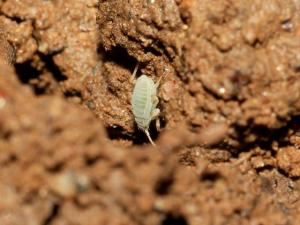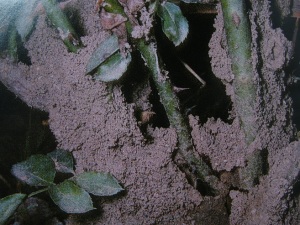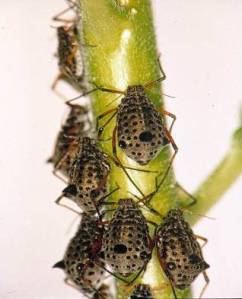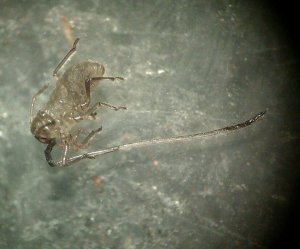I haven’t written about aphids for a while, so I thought I would indulge myself and tell you about a few of my favourite aphids. Most people’s perceptions of aphids (assuming that they know what aphids are of course) is that they live on leaves. They will I think, also possibly know that they are usually found on the undersides of leaves, although I may be assuming too much here. In fact, many species of aphid do not live on leaves; a number of species feed on shoots, twigs and branches and some actually feed on the main trunks of trees. Yet other species live on the roots of trees and herbaceous plants, such as the apple-grass aphid, Rhopalosiphum insertum which can be a pest of apples and cereals, feeding on the leaves and buds of apples and the roots of grasses and cereals. Another root-feeding aphid that is a double pest, is Pachypappa tremulae, the spruce root aphid, which host alternates between the aerial parts of aspen trees and the roots of Norway spruce; easily visible when infesting the roots of young potted plants due to the presence of white waxy tufts on its rear end.
Some aphids not only live underground feeding on roots, but are entirely dependent on being farmed by ants e.g. Tetraneura ulmi, which host-alternates between elm and grass roots, and Forda formicaria, which host-alternates between Pistachio trees and grass roots.
Both these aphids are looked after or ‘farmed’ by the yellow meadow ant Lasius flavus in exchange for donations of honeydew.
These two aphid species, along with a number of others, have an enlarged anal plate surrounded by special hairs that form the so-called trophobiotic organ. This acts as a storage device that allows the aphid to accumulate honeydew ready for the ants to remove. Those aphids that have a more casual (facultative) relationship with ants, do not have this organ which is the basis of this remarkable mutualism.
Another aphid that is farmed by ants, but in a somewhat different way, is the rather larger rose root aphid, Maculolachnus submacaula, which as its name suggests, feeds on rose roots. In this case, the ants allow the aphids above ground but only in an ant tunnel, similar to those produced by termites when they are infesting a building. I have only ever been lucky enough to see this aphid once, some 35 years ago in Norwich when I was doing my PhD and noticed things that looked like termite trails running up the main stem of one of my rose bushes. On breaking them open, well I am a curious entomologist, I found to my surprise not only ants but large brown aphids.
http://jardiweb-floralbum.forumsactifs.com/t1797-colonie-de-pucerons
for a better view of the aphid see http://www.afripics.co.za/home/products/product.php?ProductID=1301564582
But of course the really spectacular ones are those that feed on branches of trees such as the giant willow aphid Tuberolachnus salignus (famous for its sharks fin) and those from the genus Stomaphis which feed through the bark of trees such as oak and
sycamore and are possessed of truly enormous mouthparts such as those of Stomaphis aceris which feeds on sycamore
This one, despite its enormous mouthparts, is quite difficult to find as it hides underneath the bark, but luckily it is ant attended so if you see ants scurrying around on the bark of sycamore and disappearing underneath loose flaking bits, it is a good bet that if you gently lever off the loose bark you will find yourself in the presence of this weird-looking creature.
The more I learn about aphids the more I find to marvel at. Aphids really are remarkable and we know so little about so many of them and their weird and wonderful life styles.
Useful References
Blackman, R.L. & Eastop, V.F. (19 94) Aphids on the World’s Trees. An Identification and Information Guide. CABI Publishing. http://www.aphidsonworldsplants.info/index.htm
Evenhuis, H.H. (1968) The natural control of the apple grass aphid, Rhopalosiphum insertum, with remarks on the control of apple aphids in general in The Netherlands. Netherlands Journal of Plant Pathology, 74, 106-117 http://link.springer.com/article/10.1007/BF02309501#page-1
Farrell, J.A. & Stufkens, M.W. (1989) Flight activity and cereal host relationships of Rhopalosiphum spp. (Homoptera: Aphididae) in Canterbury New Zealand Journal of Journal of Crop and Horticultural Science, 17, 1-7 http://www.tandfonline.com/doi/abs/10.1080/01140671.1989.10428003
Ivens, A.B.F., Kronauer, D.J.C., Pen, I., Weissing, F.J. & Boomsma, J.J. (2012) Ants farm subterranean aphids mostly in single clone groups – an example of prudent husbandry for carbohydrates and proteins? BMC Evolutionary Biology, 12:106 http://link.springer.com/article/10.1186%2F1471-2148-12-106






Pingback: Segments (4) › Expiscor
Pingback: Not all Aphids are Pests | Don't Forget the Roundabouts
Pingback: Not all aphids are farmed by ants | Don't Forget the Roundabouts
We have an infestation of Ash Tree Boletes (Boletinellus merulioides). Yes, a mushroom. . . My research keeps coming up with a symbiotic relationship between this mushroom and a Ash Tree Root Aphid. I’m having a hard time finding out what that particular aphid is and how to get rid of it. Any information you can provide would be appreciated.
LikeLike
Interesting, what is infesting what? – I am pretty certain that the aphid is Mimeuria ulmiphila. As it is a wax covered root dwelling aphid it will be quite hard to control – I guess a systemic insecticide will be the best option
Brundrett, M.C. & Kendrick, B. (1987). The relationship between the ash bolete (Boletinellus meruloides) and a aphid parasitic on ash tree roots. Symbiosis 3, 315-320.
Krzywiec, D. (1962). Morphology and biology of Mimeuria ulmiphila (Del Guercio) (Homoptera, Aphidae), part II. Bull. Soc. Amis. Sci. Lettr. Poznan (D) 3, 63-97.
LikeLike
Pingback: Not all aphids live on the underside of leaves | Don't Forget the Roundabouts